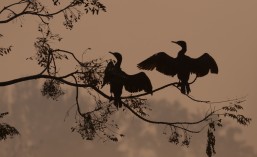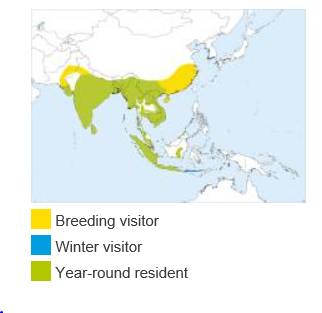Order: Anseriformes Family: Anatidae Conservation Status: Least Concern
Synonyms: Lesser Tree Duck, Indian Whistling Duck, Javan Whistling Duck, Lesser Whistling Teal
Description:
The Lesser Whistling Duck is a medium sized duck, measuring 40 cm. It has an overall rich red-brown plumage with a buffy head, neck and under parts. The upper parts are brown with buff scales whilst the rump, wing lining and upper tail coverts are dark chestnut coloured. The flanks and abdomen are light rufous with creamy streaks which are poorly defined on the upper edge of the flank. The bill and legs are slaty blue – grey and it has dark brown eyes with a yellow-orange eye ring. There is a dark grey-brown crown on the top of the head. In flight the bird appears uniformly dark except for the chestnut rump and scapulars.
There is no sexual dimorphism in adult birds.
Downy chicks are black with a white eyebrow and white patches on the back of the head, wing, lower back and rump. Juvenile birds are duller and paler versions of adults.
Call and Vocalisation:
The typical call of the Lesser Whistling Duck is a three note whistle with a high pitched and prolonged final note. In flight flocks utter a wheezy, whistling “seasick, seasick” call.
Lesser Whistling Duck call
Lesser Whistling Duck flight call
Range and Distribution:
The Lesser Whistling Duck is resident throughout the lowland wetlands of Southeast Asia and the Indian subcontinent, ranging from Indonesia, Singapore, Malaysia, Thailand, Vietnam, and Myanmar to Nepal, Sri Lanka, Bangladesh, eastern Pakistan and India. It is also found on the Andaman Islands, Nicobar Islands and the Maldives.
There is some local migratory movement driven by variations in water availability and weather.
The Lesser Whistling Duck is monotypic.
Habitat:
The Lesser Whistling Duck is found in freshwater wetlands with good vegetation, often surrounded by trees in which to roost. Rarely, they may be seen afloat on the ocean beyond the surf line.
Diet:
The main diet of the Lesser Whistling Duck is aquatic vegetation, supplemented by grass, rice, freshwater snails, insects and frogs. Small groups can often be seen foraging in dense, emergent vegetation. Feeding mostly occurs at night.
Breeding:
Lesser Whistling Ducks have an extended breeding season which peaks with the tropical rainy season. During courtship the male will face the female and raise and dip his bill in the water and swim around the female. Once paired these birds are monogamous and form life-time bonds. Nests are built near freshwater as scrapes in the ground, typically hidden in vegetation. Tree hollows and abandoned raptor, heron, stork or crow nests are also used. A clutch of 7 to 12 cream-white eggs is typically laid and is incubated by both parents for 26 to 30 days. Chicks fledge typically after 45 to 50 days after hatching. Both adult birds tend to the young, and chicks can often be seen on the backs of their parents. Being highly gregarious, Lesser Whistling Ducks often breed in loose colonies.
Courtship involves the male facing the female and dipping and raising its bill in the water and swimming around the female.


